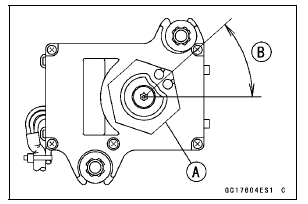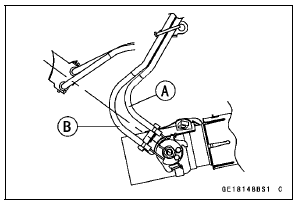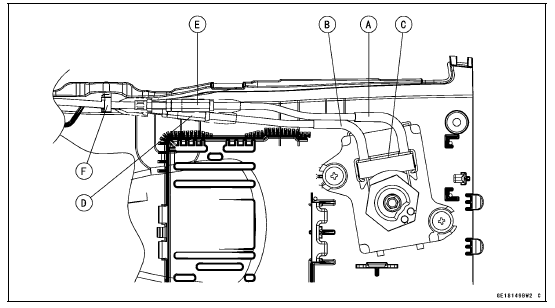

41.7° ±7° [B]
This position is original position of the pulley.
NOTE
Correct the position electrically after confirming the use is discontinued and there is no damage when differing from the angle of shown in the figure.

NOTICE
Do not correct the pulley position with the tool, forcibly. The actuator damage will occur.
If the angle is wrong, adjust the pulley (see Exhaust Butterfly Valve Actuator Installation in the Self-Diagnosis System chapter).
Open Cable (White) [A] Close Cable (Black) [B]

First, install the close cable (black) [A].
Second, install the open cable (white) [B].
Third, install the clamp [C].
Fourth, stretch the open cable (white) by using the adjuster [D].
Turn the adjuster counterclockwise until the play of the open cable becomes no play.
NOTICE
To keep the correct exhaust butterfly valve position, be sure to adjust the open cable first. Do not overstretch the cable.
Fifth, tighten the adjuster locknut (white) of the open cable securely.
Sixth, stretch the close cable (black) by using the adjuster [E].
Turn the adjuster counterclockwise until the play of the close cable becomes no play.
Seventh, turn the adjuster of the close cable (black) clockwise by 1/2 to 1 rotation.
Lastly, tighten the adjuster locknut (black) of the close cable securely.

 Exhaust Butterfly Valve Cable Removal
Exhaust Butterfly Valve Cable Removal Clutch
ClutchTransmission Assy Assembly
Install the ball bearing [A] until it is bottomed.
Turn the oil seal side to the bottom.
Special Tool - Bearing Driver Set: 57001-1129
Install the bearing holder [B].
Turn the flat side to the bottom.
Apply a non-permanent locking agent to the bearing
holder bolts [C].
Tighten: ...
Stem, Stem Bearing Installation
Replace the bearing outer races with new ones.
Drive them into the head pipe at the same time.
Special Tools - Head Pipe Outer Race Press Shaft [A]:
57001-1075
Head Pipe Outer Race Driver,
55 [B]: 57001
-1446 or Bearing Driver Set: 57001-1129
Apply grease to the outer races.
...
Coupling Bearing Inspection
Since the coupling bearing is made to extremely close
tolerances, the clearance can not normally be measured.
NOTE
It is not necessary to remove the coupling bearing for
inspection. If the bearing is removed, it will need to be
replaced with a new one.
Turn the bearing in the coupling b ...